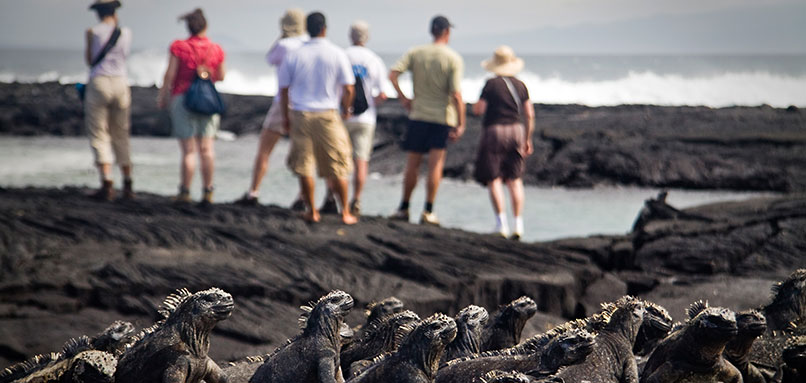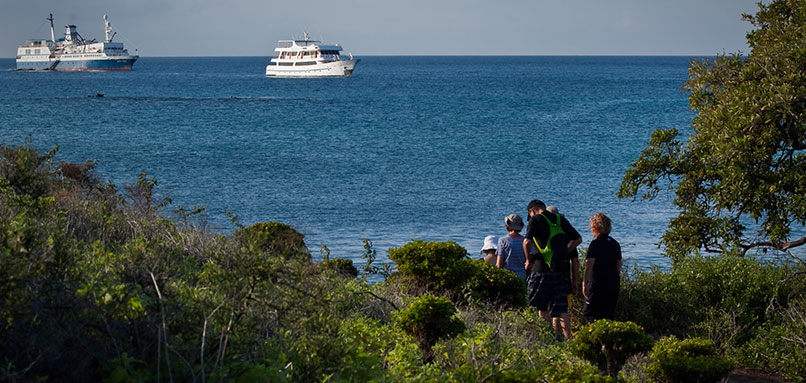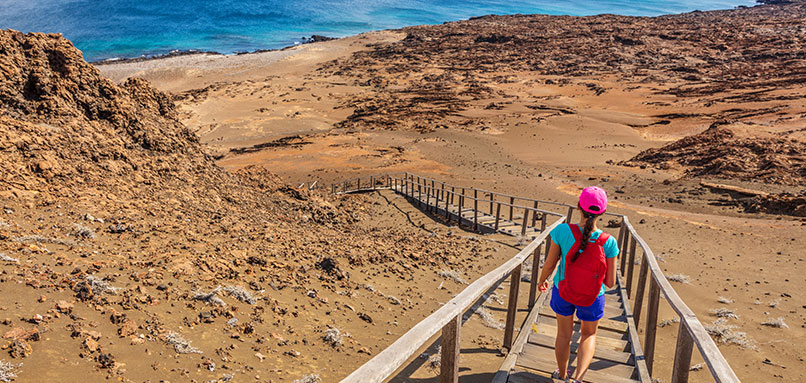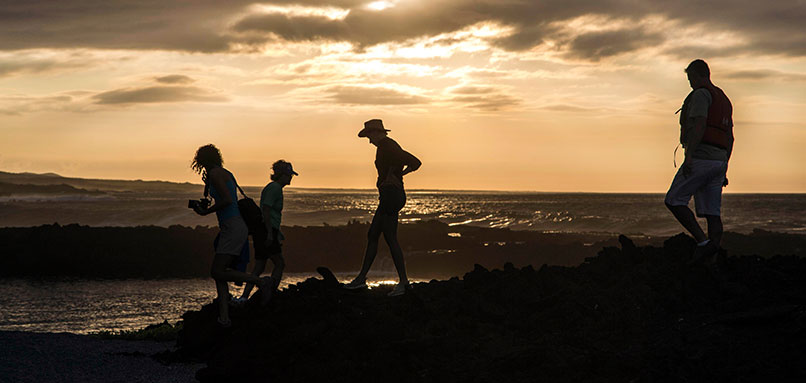Introduction
The Galapagos Islands, a mesmerizing archipelago situated in the Pacific Ocean, have long captured the imagination of travelers from around the globe. Renowned for their unique biodiversity and the groundbreaking scientific discoveries made by Charles Darwin, these islands offer an unparalleled opportunity to witness wildlife and ecosystems that exist nowhere else on Earth.
However, the increasing popularity of the Galapagos as a travel destination brings with it the responsibility to preserve its pristine environment for future generations. This is where the concept of sustainable cruising comes into play, serving as a critical bridge between the desire to explore and the imperative to protect.
Sustainable cruising in the Galapagos embodies more than just an eco-friendly way to travel; it represents a commitment to the conservation of this unique ecosystem and a contribution to the local communities that call these islands home. By choosing sustainable cruising options, visitors play a vital role in minimizing their environmental impact, supporting conservation efforts, and ensuring that the islands remain a natural sanctuary for the diverse species residing there.
As we delve into the world of sustainable Galapagos cruising, it’s essential to understand the significance of making eco-conscious travel choices. This guide aims to shed light on how each visitor can contribute to the sustainability of the Galapagos Islands while still enjoying the extraordinary experience of cruising through this enchanting archipelago. From selecting eco-friendly tours and green yachts to understanding the conservation measures in place and how they impact your visit, we will explore the various facets of responsible tourism in the Galapagos.
Embarking on a Galapagos cruise is an adventure of a lifetime, but it also entails a responsibility towards preserving the natural beauty and ecological integrity of the islands. Through sustainable practices and informed choices, travelers can ensure that their visit contributes positively to the archipelago’s preservation, making the Galapagos a lasting treasure for generations to come.
Understanding Sustainable Galapagos Cruising

The allure of the Galapagos Islands lies not only in their remarkable wildlife and pristine landscapes but also in the delicate balance that allows such marvels to thrive. Sustainable cruising in this unique archipelago is not merely a preference but a necessity, ensuring that the islands and their natural inhabitants continue to flourish for future visitors. Understanding the concept of sustainable Galapagos cruising involves recognizing the impact of tourism and taking deliberate steps to mitigate it, embracing eco-friendly practices, and supporting conservation efforts.
The Importance of Eco-Friendly Galapagos Tours
Eco-friendly tours are the cornerstone of sustainable travel in the Galapagos. These tours go beyond minimizing environmental impact; they actively contribute to the preservation of the islands’ ecosystems. Operators of such tours adhere to strict environmental guidelines, including limiting the number of visitors to sensitive areas, employing renewable energy sources on boats, and managing waste effectively. By choosing eco-friendly Galapagos tours, travelers support a model of tourism that respects and protects the natural environment, ensuring that the islands’ unique biodiversity is maintained.
Current Conservation Efforts and Their Impact on Visitors
Conservation efforts in the Galapagos are both robust and multifaceted, aiming to safeguard the islands’ natural heritage. These include rigorous regulations on tourism, research initiatives focused on understanding and preserving marine biodiversity, and community-based projects that promote sustainable living among local populations.
For visitors, these conservation measures translate into a more regulated but immensely rewarding travel experience. Entrance fees contribute directly to conservation projects, and visitor guidelines help ensure that human presence does not disturb the islands’ delicate ecosystems. Understanding these measures allows travelers to appreciate the necessity of such restrictions and their role in the larger conservation narrative.
Sustainable Galapagos cruising embodies a deep respect for nature, emphasizing the need for responsible tourism practices that prioritize the well-being of the environment over convenience or short-term gains.
How to Cruise Responsibly in the Galapagos

Cruising the Galapagos Islands offers an unparalleled opportunity to witness one of the most unique ecosystems on the planet. However, responsible cruising is paramount to ensuring the preservation of this fragile environment. By highlighting the practices aboard Fragata and Golondrina Galapagos yachts, under the umbrella of Tierra Verde Tours, we can illustrate how visitors can contribute to sustainable tourism in the archipelago.
Selecting Your Vessel Wisely
Choosing a yacht like Fragata or Golondrina, which are committed to sustainable practices, is a critical first step. Both vessels are categorized based on comfort but adhere to strict environmental guidelines. The Fragata, with its superior comfort, and the Golondrina, offering basic comfort, both operate with a clear focus on minimizing their ecological footprint, demonstrating that sustainable cruising does not compromise on the quality of the experience.
Adhering to Conservation Guidelines
Both yachts strictly follow the Galapagos National Park’s regulations, such as limited visitor numbers and controlled itineraries. This ensures that the islands are not overcrowded and that the impact on the environment is distributed evenly. As a visitor, choosing cruises that respect these guidelines is crucial for responsible tourism.
Implementing Sustainable Practices Onboard
The Fragata and Golondrina emphasize waste management, the use of eco-friendly products, energy efficiency, and water conservation. These measures significantly reduce the environmental impact of cruising. As a traveler, supporting yachts that prioritize these practices helps promote a culture of sustainability within the industry.
Contributing to Local Conservation Efforts
Both vessels not only comply with conservation measures but also actively support local conservation efforts and the Galapagos community by employing local staff and participating in conservation projects. This approach ensures that the benefits of tourism are felt by the local ecosystem and community.
Embracing Educational Opportunities
The educational programs offered onboard aim to deepen visitors’ understanding of the Galapagos ecosystem and the importance of conservation efforts. This knowledge empowers tourists to become ambassadors for sustainability, extending the impact of their visit well beyond their time in the islands.
Ensuring Guided Exploration
By ensuring that exploration is conducted under the guidance of certified Galapagos National Park guides, both yachts guarantee that visitors adhere to paths that minimize disturbance to wildlife and habitats. This practice underscores the importance of respectful interaction with the environment.
Enhancing Your Experience Through Sustainable Practices

An expedition to the Galapagos Islands is an unforgettable journey, promising encounters with unique wildlife and breathtaking landscapes. The adventure begins even before setting foot on the islands, with the crucial task of packing. Since most of the Galapagos Islands are remote and uninhabited, travelers have a single opportunity to pack right, emphasizing the need for careful planning and sustainable choices.
Choose Sustainable Gear
Lightweight and Durable Footwear: The rugged terrain of the Galapagos demands sturdy, lightweight hiking shoes. These should be complemented with thin, moisture-wicking socks to manage the heat and humidity effectively. For aquatic adventures, opt for eco-friendly water shoes that protect your feet during wet landings and prevent harm to the marine environment.
Clothing with Minimal Environmental Impact: Wearing neutral colors helps blend with the natural surroundings, minimizing stress on wildlife. Select lightweight, breathable fabrics for hiking pants and tops with sleeves, providing sun protection while being mindful of the local ecosystem. Rain gear should be light and packable, made from sustainable materials that reduce environmental footprint.
Embrace Eco-Conscious Accessories
Sun Protection: A sturdy sunhat and UV-blocking sunglasses are essential, with options for biodegradable or recycled materials enhancing your eco-friendly travel kit. When choosing sunblock, prioritize reef-safe, mineral-based formulas to protect marine life.
Responsible Snorkeling Gear: While quality snorkel gear is usually provided, bringing a personal prescription mask or snorkeling goggles can enhance your underwater experience without adding unnecessary waste. Select products made from durable, eco-friendly materials.
Pack for Conservation
Reusable Water Bottles and Containers: To avoid single-use plastics, pack a reusable water bottle and dry bags for protecting your gear. This simple step significantly reduces plastic waste and its impact on the pristine Galapagos environment.
Digital Devices and Power Banks: Minimize reliance on disposable batteries and reduce waste by bringing rechargeable devices and solar-powered chargers. This approach not only keeps your devices powered up but does so in an eco-friendly manner.
Photography and Observation Tools: Capture the majesty of the Galapagos with a high-quality camera or GoPro, ensuring you have sufficient memory cards and batteries. Choose equipment that offers longevity and reliability, reducing the need for frequent replacements and contributing to sustainable travel practices.
Financial Aspects of Sustainable Cruising

Understanding the financial nuances of sustainable cruising in the Galapagos is vital for both managing expectations and appreciating the value behind the costs. Sustainable practices aboard cruises, exemplified by responsible waste management, energy efficiency, and support for local conservation efforts, often entail higher operational expenses. These expenses are reflected in the cruise prices, ensuring that the environmental footprint is minimized, and the delicate ecosystem of the Galapagos is preserved.
Tipping as a Sustainable Practice
Tipping, while not obligatory, is a customary practice that supports fair compensation for the crew and guides who make the Galapagos cruising experience exceptional. It is an additional way to acknowledge the attentive service provided, beyond the basic tour cost. The guidelines suggest varying tipping rates depending on the cruise category, ranging from basic to luxury, ensuring that gratuities are both fair and reflective of the service level.
Why Sustainable Cruising Costs More
The higher cost of Galapagos cruises is directly linked to sustainable and conservation efforts. From employing eco-friendly technologies to supporting local conservation initiatives, these practices require additional investment. However, the value of contributing to the preservation of the Galapagos while experiencing its natural wonders offers a unique proposition to eco-conscious travelers.
The Value Proposition
Investing in a sustainable Galapagos cruise is not merely a financial transaction but a contribution to a larger conservation effort. The costs associated with such cruises support a model of tourism that seeks to balance human enjoyment with ecological preservation. By choosing sustainable cruising, travelers are part of a meaningful exchange that ensures the Galapagos Islands remain a vibrant and pristine sanctuary for future generations.
Choosing Sustainable Partners for Your Galapagos Adventure

Selecting a sustainable partner for your Galapagos adventure is crucial for ensuring that your visit contributes positively to the islands’ ecological preservation. Sustainable travel agencies, like GreenGo Travel, prioritize eco-friendly practices, conservation efforts, and the promotion of responsible tourism. These agencies collaborate with environmentally conscious cruise operators, support local conservation projects, and adhere to the Galapagos National Park guidelines, ensuring that your travel experience is both enjoyable and sustainable.
Why Choose a Sustainable Travel Agency?
A sustainable travel agency offers significant advantages, including:
- Expertise in Eco-Friendly Practices: They have in-depth knowledge of the most sustainable ways to explore the Galapagos, from selecting eco-friendly accommodations to minimizing your carbon footprint.
- Support for Conservation Projects: By booking with an agency committed to conservation, you’re indirectly contributing to the protection and preservation of the islands’ unique ecosystems.
- Responsible Tourism Advocacy: These agencies ensure that your visit supports the local economy without compromising the natural environment, enhancing the overall sustainability of the Galapagos.
Conclusion
The conclusion of our exploration into sustainable cruising in the Galapagos Islands underscores the importance of integrating sustainability into every facet of the cruising experience. This holistic approach is vital for preserving the unique ecosystems of the Galapagos while allowing visitors to marvel at their beauty.
The transition towards sustainable tourism is not solely the responsibility of cruise operators but also hinges on the choices of travelers, their good practices, the support of local communities, and the implementation of regulatory frameworks by governments.
The commitment of travelers to choose eco-friendly cruise options plays a crucial role in propelling the industry towards more sustainable practices. This demand for responsible travel can encourage operators to adopt environmentally friendly operations, benefiting the natural environment and local economies. The journey towards sustainability in the Galapagos serves as a model for other destinations, demonstrating how tourism can be a force for conservation without compromising the quality of the visitor experience.
In essence, sustainable cruising in the Galapagos is about striking a balance between exploring the natural world and preserving it for future generations. It embodies a vision for tourism that is as enriching and awe-inspiring as it is conscientious and sustainable. As we move forward, the collective efforts of all parties involved in the tourism industry will determine the impact of our travel on the planet’s most precious and fragile environments.